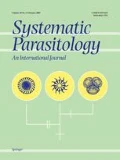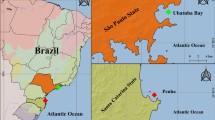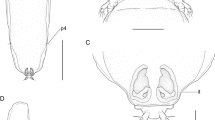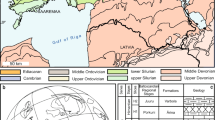Abstract
A new species of digenean, Pseudobacciger cheneyae n. sp., is described from the intestines of Weber’s chromis (Chromis weberi Fowler & Bean) from off Lizard Island, Great Barrier Reef, Australia. This species differs from the three described species of Pseudobacciger Nahhas & Cable, 1964 [P. cablei Madhavi, 1975, P. harengulae Yamaguti, 1938 and P. manteri Nahhas & Cable, 1964] in combinations of the size of the suckers and the length of the caeca. The host of the present species is a perciform (Family Pomacentridae) which contrasts with previous records of the genus which are almost exclusively from clupeiform fishes. The genus Pseudobacciger is presently recognised within the family Faustulidae (Poche, 1926) but phylogenetic analyses of 28S and ITS2 rDNA show that the new species bears no relationship to species of four other faustulid genera (Antorchis Linton, 1911, Bacciger Nicoll, 1924, Paradiscogaster Yamaguti, 1934 and Trigonocryptus Martin, 1958) but that instead it is nested within the Gymnophalloidea (Odhner, 1905) as sister to the Tandanicolidae (Johnston, 1927). This result suggests that the Faustulidae is polyphyletic.


Similar content being viewed by others
Notes
urn:lsid:zoobank.org:act: 369B1E27-B899-48CD-ACD6-0893B314C1C4.
urn:lsid:zoobank.org:act: AB0A60B3-E5AC-4EE4-8990-8664A738A1E9.
References
Aiken, H. M., Bott, N. J., Mladineo, I., Montero, F. E., Nowak, B. F., & Hayward, C. J. (2007). Molecular evidence for cosmopolitan distribution of platyhelminth parasites of tunas (Thunnus spp.). Fish and Fisheries, 8, 167–180.
Anderson, G. R., & Barker, S. C. (1998). Inference of phylogeny and taxonomy within the Didymozoidae (Digenea) from the second internal transcribed spacer (ITS2) of ribosomal DNA. Systematic Parasitology, 41, 87–94.
Barker, S. C., Cribb, T. H., Bray, R. A., & Adlard, R. D. (1994). Host-parasite associations on a coral reef: Pomacentrid fishes and digenean trematodes. International Journal for Parasitology, 24, 643–647.
Barnett, L. J., Miller, T. L., & Cribb, T. H. (2014). A review of the currently recognised zoogonid cercariae, including the identification and emergence ecology of Cercaria capricornia XI (Digenea: Zoogonidae) from Nassarius olivaceus (Gastropoda: Nassariidae) in Central Queensland, Australia. Folia Parasitologica (in press).
Bartoli, P., Bray, R. A., & Gibson, D. I. (2006). Four closely related but forgotten species of Rhipidocotyle Diesing, 1858 (Digenea: Bucephalidae) in fishes from European seas. Systematic Parasitology, 65, 129–149.
Bartoli, P., & Gibson, D. I. (2007). Synopsis of the life cycles of Digenea (Platyhelminthes) from lagoons of the northern coast of the western Mediterranean. Journal of Natural History, 41, 1553–1570.
Bowles, J., Hope, M., Tiu, W. U., Liu, X. S., & McManus, D. P. (1993). Nuclear and mitochondrial genetic markers highly conserved between Chinese and Philippine Schistosoma japonicum. Acta Tropica, 55, 217–229.
Bray, R. A. (1982). Two new species of Bacciger Nicoll, 1914 (Digenea: Fellodistomidae) from mullet in Australia. Journal of Natural History, 16, 23–29.
Bray, R. A. (2001). Family Tandanicolidae Johnston, 1927. In: Gibson, D. I., Jones, A. & Bray, R. A. (Eds) Keys to the Trematoda. Vol. 1. Wallingford: CAB International, pp. 295−298.
Bray, R. A. (2002). Superfamily Gymnophalloidea Odhner, 1905. In: Gibson, D. I., Jones, A. & Bray, R. A. (Eds) Keys to the Trematoda. Vol. 1. Wallingford: CAB International, pp. 243−244.
Bray, R. A. (2008). Family Faustulidae Poche, 1926. In: Bray, R. A., Gibson, D. I. & Jones, A. (Eds) Keys to the Trematoda. Vol. 3. Wallingford: CABI Publishing and the Natural History Museum, pp. 509−522.
Bray, R. A., & Cribb, T. H. (1998). Lepocreadiidae (Digenea) of Australian coastal fishes: new species of Opechona Looss, 1907, Lepotrema Ozaki, 1932 and Bianium Stunkard, 1930 and comments on other species reported for the first time or poorly known in Australian waters. Systematic Parasitology, 41, 123–148.
Bray, R. A., & Cribb, T. H. (2002). Lepocreadiinae lepocreadiids (Digenea) from tetraodontiform fishes in the waters off Tasmania, Queensland and Moorea, French Polynesia. Acta Parasitologica, 47, 6–13.
Bray, R. A., & Cribb, T. H. (2004). Species of Lecithocladium Lühe, 1901 (Digenea, Hemiuridae) from Australian marine fishes, with a description of a new species from various hosts off eastern Australia. Acta Parasitologica, 49, 3–11.
Bray, R. A., Cribb, T. H., & Barker, S. C. (1993a). The Hemiuroidea (Digenea) of pomacentrid fishes (Perciformes) from Heron Island, Queensland, Australia. Systematic Parasitology, 24, 159–184.
Bray, R. A., Cribb, T. H., & Barker, S. C. (1993b). The Lepocreadiidae (Digenea) of pomacentrid fishes (Perciformes) from Heron Island, Queensland, Australia. Systematic Parasitology, 26, 189–200.
Bray, R. A., Cribb, T. H., & Barker, S. C. (1994). Fellodistomidae and Lepocreadiidae (Platyhelminthes: Digenea) from chaetodontid fishes (Perciformes) from Heron Island, southern Great Barrier Reef, Queensland, Australia. Invertebrate Taxonomy, 8, 545–581.
Bray, R. A., Littlewood, D. T. J., Herniou, E. A., Williams, B., & Henderson, R. E. (1999). Digenean parasites of deep-sea teleosts: a review and case studies of intrageneric phylogenies. Parasitology, 119, S125–S144.
Chun, S. K., Chang, D. S., Park, C. K., Kim, Y. G., & Rho, Y. G. (1981). Basic studies for the production of the hard clam Meretrix lusoria (Roding) in Jeonnbug farming area. Bulletin of Fisheries Research and Development Agency, 26, 7–36.
Cribb, T. H., Anderson, G. R., Adlard, R. D., & Bray, R. A. (1998). A DNA-based demonstration of a three-host life cycle for the Bivesiculidae (Platyhelminthes: Digenea). International Journal for Parasitology, 28, 1791–1795.
Cribb, T. H., Anderson, G. R., & Bray, R. A. (1999). Faustulid trematodes (Digenea) from marine fishes of Australia. Systematic Parasitology, 44, 119–138.
Cribb, T. H., & Bray, R. A. (1994). A review of the Tandanicolinae (=Monodhelminthinae) (Digenea: Fellodistomidae), with a description of Prosogonarium angelae n. sp. Systematic Parasitology, 27, 187–205.
Cribb, T. H., Bray, R. A., & Barker, S. C. (1992). Zoogonidae (Digenea) from southern Great Barrier Reef fishes with a description of Steganoderma (Lecithostaphylus) gibsoni n. sp. Systematic Parasitology, 23, 7–12.
Cribb, T. H., Bray, R. A., & Barker, S. C. (1994). Bivesiculidae and Haplosplachnidae (Digenea) from fishes of the southern Great Barrier Reef, Australia. Systematic Parasitology, 28, 81–97.
Cribb, T. H., Miller, T. L., Bray, R. A., & Cutmore, S. C. (2014). The sexual adult of Cercaria praecox Walker, 1971 (Digenea: Fellodistomidae), with the proposal of Oceroma n. g. Systematic Parasitology, 88, 1–10.
Curran, S. S., Tkach, V. V., & Overstreet, R. M. (2006). A review of Polylekithum Arnold, 1934 and its familial affinities using morphological and molecular data, with description of Polylekithum catahoulensis sp. nov. Acta Parasitologica, 51, 238–248.
Derbel, H., Chaari, M., & Neifar, L. (2011). Redescription of Rhipidocotyle galeata (Rudolphi, 1819) (Digenea, Bucephalidae), the type species of Rhipidocotyle Diesing, 1907. Zoosystema, 33, 133–139.
Diaz, P. E., Bray, R. A., & Cribb, T. H. (2013). Paradiscogaster flindersi and P. oxleyi n. sp. (Digenea: Faustulidae): overlapping host and geographical distributions in corallivore chaetodontid fishes in the tropical Indo-West Pacific. Systematic Parasitology, 86, 87–99.
Diaz, P. E., & Cribb, T. H. (2013). Paradiscogaster leichhardti sp. nov. (Digenea: Faustulidae) in Chaetodontoplus meredithi (Perciformes: Pomacanthidae) from Heron Island, Great Barrier Reef. Memoirs of the Queensland Museum, 58, 49–53.
Dimitrov, G. I., Bray, R. A., & Gibson, D. I. (1999). A redescription of Pseudobacciger harengulae (Yamaguti, 1938) (Digenea: Faustulidae) from Sprattus sprattus phalericus (Risso) and Engraulis encrasicholus ponticus Alexandrov off the Bulgarian Black Sea coast, with a review of the genus Pseudobacciger Nahhas & Cable, 1964. Systematic Parasitology, 43, 133–146.
Edgar, R. C. (2004). MUSCLE: multiple sequence alignment with high accuracy and high throughput. Nucleic Acids Research, 32, 1792–1797.
Euzet, L., & Combes, C. (1980). Les problemes de l’espece chez les animaux parasites. Memoires Societe Zoologique de France, 40, 239–285.
Fishelson, L. (1998). Behaviour, socio-ecology and sexuality in damselfishes (Pomacentridae). Italian Journal of Zoology, 65, 387–398.
Gaevskaya, A. V. (1996). [New records of trematodes from eastern Atlantic fishes]. Parazitologiya, 30, 504–509 (In Russian).
Gaevskaya, A. V., & Naidenova, N. N. (1996). [Revision of Bacciger bacciger (Trematoda: Fellodistomidae) from fishes of the Black and Mediterranean Seas]. Parazitologiya, 30, 39–44 (In Russian).
Hall, K. A., Cribb, T. H., & Barker, S. C. (1999). V4 region of small subunit rDNA inidicates polyphyly of the Fellodistomidae (Digenea) which is supported by morphology and life-cycle data. Systematic Parasitology, 43, 81–92.
Hunter, J. A., & Cribb, T. H. (2012). A cryptic complex of species related to Transversotrema licinum Manter, 1970 from fishes of the Indo-West Pacific, including descriptions of ten new species of Transversotrema Witenberg, 1944 (Digenea: Transversotrematidae). Zootaxa, 3176, 1–44.
Johnston, T. H. (1927). New trematodes from an Australian siluroid. Transactions of the Royal Society of South Australia, 51, 129–136.
Kim, Y. G., & Chun, S. K. (1984). Studies on the life history of Bacciger harengulae. Bulletin of the Korean Fisheries Society, 17, 449–470.
Korotaeva, V. D. (1969). [Helminths of some food-fishes of the order Clupeiformes in the sea near Australia and New Zealand.] In: Markevich, A. P. (Ed.) Problemy Parazitologii. Trudy Nauchno Konferentsii. Parazitologov USSR (6th), pp. 237–238 (In Russian).
Kurochkin, Y. V. (1970). [New trematode species Discogasteroidinae (Trematoda, Fellodistomatidae) from marine fishes of Australia]. Parazitologiya, 4, 111–115 (In Russian).
Littlewood, D. T. J., Curini-Galletti, M., & Herniou, E. A. (2000). The interrelationships of Proseriata (Platyhelminthes: Seriata) tested with molecules and morphology. Molecular Phylogenetics and Evolution, 16, 449–466.
Machida, M., & Uchida, K. (2001). Digenean trematodes from pomacanthid fishes of Japan and Palau. Bulletin of the National Science Museum, Tokyo, Series A, Zoology, 27, 217–227.
Maddison, W. P., & Maddison, D. R. (2009). Mesquite: a modular system for evolutionary analysis. Version 2.72 http://mesquiteproject.org.
Madhavi, R. (1975). Digenetic trematodes from marine fishes of Waltair coast, Bay of Bengal: Family Fellodistomidae. Revista di Parasitologia, 36, 115–128.
Manter, H. W. (1969). Some digenetic trematodes of marine fishes of New Caledonia. Part IV. Hemiuridae and Summary. Proceedings of the Helminthological Society of Washington, 36, 194–204.
Miller, M. A., Pfeiler, E., & Schwartz, T. (2010). Creating the CIPRES Science Gateway for inference of large phylogenetic trees. In: Proceedings of the Gateway Computing Environments Workshop (GCE), 14 Nov. 2010, New Orleans, LA, pp. 1–8.
Miller, T. L., Bray, R. A., & Cribb, T. H. (2011). Taxonomic approaches to and interpretation of host-specificity of trematodes of fishes: lessons from the Great Barrier Reef. Parasitology, 138, 1710–1722.
Nahhas, F. M., & Cable, R. M. (1964). Digenetic and aspidogastrid trematodes from marine fishes of Curaçao and Jamaica. Tulane Studies in Zoology, 11, 169–228.
Olson, P. D., Cribb, T. H., Tkach, V. V., Bray, R. A., & Littlewood, D. T. J. (2003). Phylogeny and classification of the Digenea (Platyhelminthes: Trematoda). International Journal for Parasitology, 33, 733–755.
Ormond, R. F. G., Roberts, J. M., & Jan, R.-Q. (1996). Behavioural differences in microhabitat use by damselfishes (Pomacentridae): implications for reef fish biodiversity. Journal of Experimental Marine Biology and Ecology, 202, 85–95.
Pankov, P., Webster, B. L., Blasco-Costa, I., Gibson, D. I., Littlewood, D. T. J., Balbuena, J. A., & Kostadinova, A. (2006). Robinia aurata n. g., n. sp. (Digenea: Hemiuridae) from the mugilid Liza aurata with a molecular confirmation of its position within the Hemiuroidea. Parasitology, 133, 217–227.
Parukhin, A. M. (1976). [Parasitic worms of benthic fishes of the southern seas.] Kiev: Naukova Dumka, 184 pp (In Russian).
Pearson, J. C. (1968). Observations on the morphology and life-cycle of Paucivitellosus fragilis Coil, Reid & Kuntz, 1965 (Trematoda: Bivesiculidae). Parasitology, 58, 769–788.
Pleijel, F., Jondelius, U., Norlinder, E., Nygren, A., Oxelman, B., Schander, C., Sundberg, P., & Thollesson, M. (2008). Phylogenies without roots? A plea for the use of vouchers in molecular phylogenetic studies. Molecular Phylogenetics and Evolution, 48, 369–371.
Posada, D. (2008). jModelTest: Phylogenetic model averaging. Molecular Biology and Evolution, 25, 1253–1256.
Randall, J. E., Allen, G. R., & Steene, R. C. (1997). The complete divers’ and fishermen’s guide to fishes of the Great Barrier Reef. Bathurst: Crawford House Publishing, 557 pp.
Ronquist, F., Teslenko, M., van der Mark, P., Ayres, D. L., Darling, A., Hohna, S., Larget, B., Liu, L., Suchard, M. A., & Huelsenbeck, J. P. (2012). MrBayes 3.2: Efficient Bayesian phylogenetic inference and model choice across a large model space. Systematic Biology, 61, 539–542.
Sambrook, J., & Russell, D. W. (2001). Molecular Cloning: A Laboratory Manual (p. 2344). Cold Spring Harbor, New York: Cold Spring Harbor Laboratory Press.
Scholz, T. (2002). Family Gymnophallidae Odhner, 1905. In: Gibson, D. I., Jones, A. & Bray, R. A. (Eds) Keys to the Trematoda. Vol. 1. Wallingford: CAB International, pp. 245−251.
Stamatakis, A., Hoover, P., & Rougemont, J. (2008). A rapid bootstrap algorithm for the RAxML web servers. Systematic Biology, 57, 758–771.
Wilson, S. K., Burgess, S. C., Cheal, A. J., Emslie, M., Fisher, R., Miller, I., Polunin, N. V. C., & Sweatman, H. P. A. (2008). Habitat utilization by coral reef fish: implications for specialists vs. generalists in a changing environment. Journal of Animal Ecology, 77, 220–228.
Yamaguti, S. (1934). Studies on the helminth fauna of Japan. Part 2. Trematodes of fishes. Japanese Journal of Zoology, 5, 249–541.
Yamaguti, S. (1938). Studies on the Helminth Fauna of Japan. Part 21. Trematodes of Fishes, IV. Kyöto: Yamaguti, S., 139 pp.
Acknowledgements
We thank K. L. Cheney and E. C. McClure for their help collecting specimens and the staff of the Lizard Island Research Station for their support. This work was funded by an Australian Research Council Discovery Grant awarded to T. H. Cribb and a Sea World Research and Rescue Foundation (SWRRFI) awarded to D. Sun and T. H. Cribb.
Author information
Authors and Affiliations
Corresponding author
Rights and permissions
About this article
Cite this article
Sun, D., Bray, R.A., Yong, R.QY. et al. Pseudobacciger cheneyae n. sp. (Digenea: Gymnophalloidea) from Weber’s chromis (Chromis weberi Fowler & Bean) (Perciformes: Pomacentridae) at Lizard Island, Great Barrier Reef, Australia. Syst Parasitol 88, 141–152 (2014). https://doi.org/10.1007/s11230-014-9494-3
Received:
Accepted:
Published:
Issue Date:
DOI: https://doi.org/10.1007/s11230-014-9494-3




